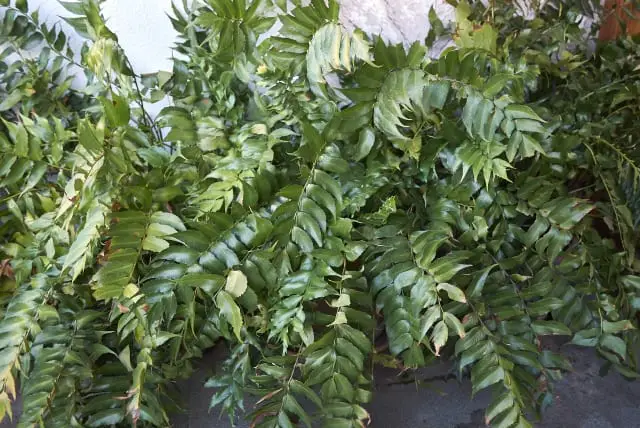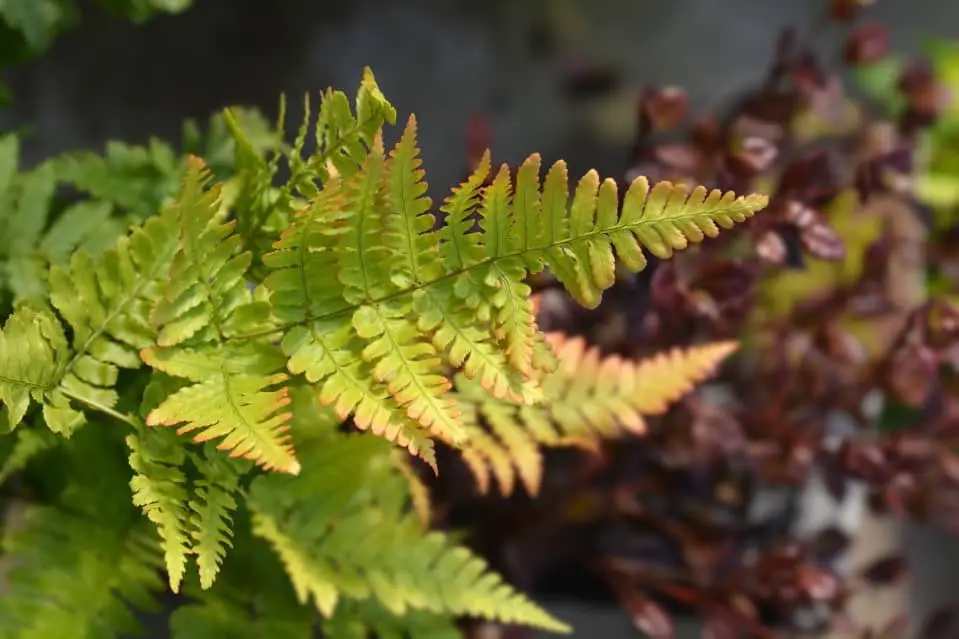Ferns are classic shade garden plants. If you have a corner of the yard that is always in shadow, or a shady room in the house, ferns are a great option for adding some natural beauty. However, despite a general preference for shade, many ferns need at least partial sun through the day to thrive. For the best results, you need to pick a variety that is especially well adapted to full shade.
The best ferns for full shade are from the Dryopteris, Polystichum and Asplenium varieties that naturally grow in dense woodland. Good examples are the Wallich’s wood fern, Soft shield fern and Hart’s tongue fern. Several other ornamental ferns can also do well in deep shade, including Sunset fern, Japanese painted fern, Holly ferns and Maidenhair ferns. Both indoor and outdoor options are available, and there is plenty of choice.
Ferns are found most abundantly in shady habitats – dense woodlands and deep gorges or gullies – and so it makes sense that they can flourish on limited sun. Of course, no plant will survive in total darkness, but there are a wide range of ferns that can grow well even in full shade.
Here are twenty of the best varieties that can thrive in the gloom – starting with outdoor favourites, and followed by the best options for shade-loving house plants. There is a good range of options to choose from for both color and shape, so with careful selection, even the dreariest spots can be given new vitality.
Shade-loving ferns
Several Dryopteris varieties do especially well in the shade. One notable example is Wallich’s wood fern (Dryopteris wallichiana), a vigorous variety with fronds that emerge a yellow or brown color, before maturing to a glossy bright green on a dark stem. The cultivar ‘Caramel gold’ is especially eye-catching.

Wallich’s wood fern
- Drypopteris wallichiana
- Semi-evergreen
- Partial or full shade
- Height: up to 1 m
- Soil: acid, neutral or alkaline. Moist, well-drained.
Another good choice is the Sunset fern (Dryopteris lepidopoda), which has even more beautiful reddy-bronze fronds that are most colorful when newly emerging in the spring. As the fronds transition over time to a paler green, the pattern of colors can be strikingly beautiful.

Sunset fern
- Dryopteris lepidopoda
- Semi-evergreen
- Full or partial shade
- Height: up to 1 m
- Soil: acid or neutral. Moist, well-drained.
As a bonus, the Sunset fern tends to lose its color more quickly in the sun, and so a spot in the deep shade should keep the display lasting for longer.

Next is a more delicate variety, the Soft Shield fern (Polystichum setiferum), which is noted for its finely divided and serrated leaflets (pinnae), and bushy growth habit.

Soft Shield fern
- Polystichum setiferum
- Evergreen
- Full or partial shade
- Height: 0.5 – 1 m
- Soil: Acid, neutral or alkaline. Moist, well-drained.
Another good option from the Polystichum genus is the Japanese Lace, or Tassel fern (Polystichum polyblepharum). This is a more upright variety, with long, deep green fronds that fill the space well. It also comes in a popular cultivar ‘Jade’, which has strikingly pale green foliage when newly emerged.

Tassel fern
- Polystichum polyblepharum
- Evergreen
- Partial or full shade
- Height: up to 1 m
- Soil: acid, neutral or alkaline. Moist, well-drained.
On the theme of delicacy, the Lady fern (Athyrium filix-femina) is another great example of a classic fern that loves the shade. The finely divided and intricate fronds seem to have a fragility that belies the hardiness of the species. It will grow well in deep shade and will happily survive through cold winters, bursting out afresh in the spring.

Lady fern
- Athyrium filix-femina
- Deciduous
- Prefers partial or full shade
- Height: up to 1 m
- Soil: acid or neutral. Moist, poor drainage tolerated.
Changing style significantly, another group that thrives in shade are the Asplenium ferns, such as the many varieties of Hart’s tongue fern. One of the toughest ferns going, the Hart’s tongue forms a rosette of single bladed fronds and can survive on thin, dry soil. Hart’s tongue ferns are found equally commonly clinging to old stone walls, as to dark, damp banks in the deep woods.

Hart’s tongue fern
- Asplenium scolopendrium
- Evergreen
- Prefers partial or full shade
- Height: up to 0.5 m
- Soil: alkaline or neutral. Moist, well drained.
There are several notable varieties of Hart’s tongue, with cresting, crinkling and frilly edges to the fronds (known collectively as the ‘Crispum’ and ‘Cristatum’ groups). This adds a bit more interest to the plant, although the parent variety undoubtedly has its own stern, glossy beauty.
Finally, another fern with glossy foliage that enjoys the shade is the Holly fern. With broad green pinnae that look more like the leaves of a flowering plant, the Holly fern can be an interesting contrast to the more typical style of feathery fronds.

Holly fern
- Cyrtomium falcatum
- Evergreen or semi-evergreen
- Full or partial shade
- Height: up to 1 m
- Soil: acid, neutral or alkaline. Moist, well-drained.
Ferns that can tolerate deep shade
While the varieties mentioned so far have a particular talent for growing in full shade, there are many other varieties that will grow successfully under these conditions – even if they may not thrive as well as they would in partial shade, with a bit of dappled sun.
First up is the dramatic Ostrich fern.

Ostrich fern
- Matteuccia struthiopteris
- Deciduous
- Full or partial shade
- Height: up to 1.5 m
- Soil: acid or neutral. Moist, well-drained.
Shapely and stylish, the shuttlecock of fronds grows tall and bushy (like an ostrich feather). This variety can spread through the soil with creeping rhizomes, so is a good choice if you want to fill a large shady area quickly, but needs management in a smaller space.
If your shade garden also has a tendency to be damp – or even waterlogged – there are a couple of tall-growing varieties that are particularly suited to wet shade: the Marsh fern and Royal fern. These ferns put on impressive growth and are also good options for large areas.

Royal fern
- Osmunda regalis
- Deciduous
- Full or partial shade, and full sun
- Height: up to 2.5 m
- Soil: acid, neutral or alkaline. Moist, poor drainage tolerated.

Marsh fern
- Thelypteris palustris
- Deciduous
- Partial or full shade
- Height: up to 1 m
- Soil: acid or neutral. Moist, tolerates poor drainage.
At the other end of the scale, Northern maidenhair ferns are low growing and well behaved, with small circular pinnae on dark stalks. They have a daintiness that is very attractive, and grows as a cascade of checkered foliage.

Northern maidenhair fern
- Adiantum pedatum
- Deciduous
- Partial or full shade
- Height: up to 0.5 m
- Soil: acid, neutral or alkaline. Moist, well-drained.
To end, two of the most popular ornamental varieties of fern will also survive well in full shade. The Japanese painted fern is another low growing variety noted for its color and beauty. The Autumn fern is another perennial favorite, with coppery fringes to the fronds that tend to fade in the sun with age. Again, this is a good reason for trying it in deeper shade.

Japanese painted fern
- Athyrium niponicum
- Deciduous
- Prefers partial shade
- Height: up to 0.5 m
- Soil: acid, neutral or alkaline. Moist, well-drained.

Autumn fern
- Dryopteris erythrosora
- Semi-evergreen
- Full or partial shade, and full sun
- Height: up to 1 m
- Soil: tolerant of most pH and drainage conditions.
Best indoor ferns for shady corners
If you are looking for a fern to liven up a gloomy room, there is a similar wide range of options available as for the garden. In particular, tropical varieties can do very well indoors, and so there are extra choices open to you for ferns that like the shade and the climate in the home.
To start, there is the ever-popular Maidenhair fern.

Maidenhair fern
- Adiantum raddianum
- Evergreen
- Partial shade
- Height: up to 0.5 m
- Soil: neutral or alkaline. Moist, well-drained.
Prized for its delicate foliage and shower of leaflets that look like green confetti, the most common choice for indoors is the Delta maidenhair (Adiantum raddianum). This variety can thrive in the shade, but other, related varieties of Maidenhair can do just as well.
For color as well as fine foliage, the silver lace fern (Pteris evergemiensis) is a variegated brake fern that is happy in full shade, and so perfect for brightening a gloomy corner.

Silver lace fern
- Pteris evergemiensis
- Evergreen
- Partial or full shade
- Height: up to 0.5 m
- Soil: neutral or alkaline. Moist, well-drained.
Another option for prettiness with a twist is the Rabbit’s foot fern.

Rabbit’s foot fern
- Davallia solida (var. fejeensis)
- Evergreen
- Partial shade
- Height: up to 1 m
- Soil: acid or neutral. Moist, well-drained.
The fronds are complemented by the striking hairy rhizomes that curl over the edges of the pot, giving it a weird and wonderful appearance. Again, the Rabbit’s foot grows well in deep shade, and so is a safe choice even for shadowy rooms.
For a more dramatic effect, the bushy and luscious Macho fern also likes the shade. It can be grown well in a hanging basket and provide a cascade of dark green foliage to fill the space.

Macho fern
- Nephrolepis biserrata
- Evergreen
- Partial or full shade
- Height: up to 2 m
- Soil: acid or neutral. Moist, well-drained
And finally, to finish, there are a couple of broad-leafed ferns – the Bird’s nest and Crocodile ferns.

Bird’s nest fern
- Asplenium nidus
- Evergreen
- Partial or full shade
- Height: up to 1 m
- Soil: acid or neutral. Moist, well-drained.

Crocodile fern
- Microsorum musifolium
- Evergreen
- Partial to full shade
- Height: up to 1 m
- Soil: Acid or neutral. Moist, well-drained.
The Bird’s nest is related to the Hart’s tongue fern, but better suited to an indoor climate. The Crocodile fern has a wonderful, scaly texture to the fronds, which makes it easy to understand how it got its name.
Shade is an asset when it comes to fern gardening, but even with their natural preference for protection from the sun, careful selection of the right fern variety is needed to get the best outcome when planting in deep shade.
